This resource provides information to primary care providers and practices on how to implement opioid use disorder treatment using buprenorphine. It identifies common barriers and strategies to overcome them. It documents step-by-step tactics to support buprenorphine implementation.
Dashboard: Filter Bricks
Main page content


The EAP Prescription Drug Toolkit and Fact Sheets provide guidance related to counseling, referrals, and follow-up services (e.g., alternatives to prescription drugs, workplace drug misuse and relapse prevention, dangers of combined drug use, screenings, and evaluations before returning to work).

This Advisory, based on TIP 49, Incorporating Alcohol Pharmacotherapies Into Medical Practice, focuses on medication and related treatment decisions made after screening and assessment for AUD, and medically supervised withdrawal, if necessary. Alcohol consumption should not stop abruptly in those patients who have consumed alcohol regularly over a prolonged period of time. This Advisory is meant as an overview of AUD medications to facilitate abstinence.

This quick guide contains an overview of the challenges associated with tobacco cessation and the benefits of being tobacco-free for individuals as well as those of a smoke-free workplace. It also includes tips that substance use disorder treatment settings can use to implement their own tobacco cessation programs.
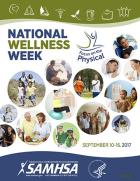
A component of SAMHSA's Wellness initiative, this poster emphasizes "Focus on the Physical," and shows a variety of images of people living a healthy lifestyle such as exercising, sleeping, getting routine checkups, etc.

Anima Promueve a que los profesionales de la salud médicos que brinden serviciosa las personas con trastornos de salud mental, servicios que se enfoquen en sus necesidades. Ofrece datos Brinda hechos sobre los trastornos mentales, indican las ocho dimensiones del bienestar, y brinda consejos para colaborar con los proveedores de salud mental.


Explica a los consumidores lo que es el bienestar y cómo afecta a la calidad de vida en general, sobre todo para las personas con trastornos de salud mental. Describe las ocho dimensiones del bienestar y ofrece sugerencias sobre cómo las personas pueden aplicarlas a su propia vida para mejorar su bienestar general.

APRENDA SOBRE LAS OCHO DIMENSIONES DEL BIENESTAR (Cartel)
Como parte de la Iniciativa de SAMHSA para el Bienestar, este cartel enumera las ocho dimensiones del bienestar: social, ambiental, física, emocional, espiritual, ocupacional, intelectual y financiera. Promueve la comunicación entre las personas con trastornos de salud mental, los profesionales y los proveedores de salud. Tamaño del cartel 24 x 18 pulgadas (aproximadamente 61 x 46 cm).

This fact sheet recognizes wellness as an important part of recovery and notes its value in reducing morbidity and mortality among people living with mental illness. It explains the eight dimensions of wellness and how these dimensions impact overall health.

This document explains to consumers the importance of wellness and how it affects overall quality of life, particularly for people living with mental illness. It also gives a brief overview of the eight dimensions of wellness: social, environmental, physical, emotional, spiritual, occupational, intellectual, and financial.
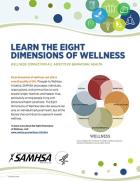
A component of SAMHSA's wellness initiative, this poster encourages mental health consumers, professionals, and primary care providers to communicate about overall wellness. The poster presents a diagram of the eight dimensions of wellness: social, environmental, physical, emotional, spiritual, occupational, intellectual, and financial. The poster comes folded and is 24 inches x 18 inches.

Lists questions consumers can ask themselves to help them decide whether to seek help for a substance abuse problem, a mental health issue, or both. Urges those who answered "yes" to any of the questions to seek help and lists resources for more information.

This fact sheet encourages clinicians to provide consumer-centered care to people living with mental illness. It provides facts about mental health issues and lists the eight dimensions of wellness. The fact sheet includes strategies for providing care and connecting with a patient's mental health provider.

This comprehensive kit provides substance use disorder treatment professionals with a year-long intensive outpatient treatment model. Professionals can use this model when treating clients who are dependent on stimulant drugs, such as methamphetamine and cocaine.
The referenced PowerPoint Presentation Sessions are available for download.
View recommendations for related products.

This guide contains patient materials for an intensive outpatient treatment course for stimulant misuse. It provides handouts to use in individual and conjoint sessions, and sessions on early recovery skills and relapse prevention.

This brochure lists questions to ask yourself to help decide whether to seek help for mental illness, substance use disorders, or both. It urges people who answer "yes" to any of the questions to seek help and provides resources for more information.

This chart book reports estimates of mental health service use among adults in the United States within different racial and ethnic groups. Highlights include past year use of mental health service, use of prescription psychiatric medication, and use of outpatient and inpatient mental health service.

This report presents spending information for treatment of mental illness, substance use disorders, or both for people only enrolled in Medicaid, and those enrolled in both Medicaid and Medicare. The report also covers fee-for-service spending and managed care spending.

This workbook contains useful self-help tools and concepts to strengthen recovery from the misuse of stimulants. The workbook is designed as a pocket-size journal with space to record ideas and reminders about relapse triggers, mooring lines, and reasons for staying abstinent.

Lists questions consumers can ask themselves to help them decide whether to seek help for a substance abuse problem, a mental health issue, or both. Urges those who answered "yes" to any of the questions to seek help and lists resources for more information

Lists questions consumers can ask themselves to help them decide whether to seek help for a substance abuse problem, a mental health issue, or both. Urges those who answered "yes" to any of the questions to seek help and lists resources for more information

Lists questions consumers can ask themselves to help them decide whether to seek help for a substance abuse problem, a mental health issue, or both. Urges those who answered "yes" to any of the questions to seek help and lists resources for more information.

This manual helps clinicians design and implement intensive outpatient treatment programs for people living with substance use disorder conditions. It discusses cultural competence and approaches, use of 12-step programs, cognitive behavioral therapy, and therapeutic communities.
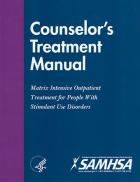
This manual contains materials, such as talking points and handouts, to help counselors conduct intensive outpatient treatment sessions. The manual discusses five types of sessions for treating adults who misuse substances. Sessions address recovery, relapse prevention, social support, and family education.

This manual provides clinical practice guidelines for using medications in the medication-assisted treatment of alcohol use disorder. It offers guidance on prescribing acamprosate, disulfiram, oral naltrexone, and extended-release injectable naltrexone. The manual also discusses patient management. Access the literature review.
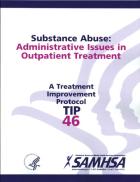
This manual provides guidelines for administrators on addressing issues in outpatient treatment for alcohol and substance misuse. It discusses cultural competence, management and strategic collaborations, human resources, financing, and performance and outcomes improvement.

This manual guides clinicians through stages of primary care for alcohol and substance misuse in adult patients. It discusses warning signs of misuse, screening and follow-up, brief intervention, assessment, treatment models, and legal issues. It includes four screening tools.

This guide enhances the counselor’s treatment manual in the Matrix series, addressing the specific needs of women who misuse stimulants. It contains materials to help counselors conduct intensive outpatient treatment sessions on relationships, trauma, body image, and family roles.

This guide highlights behavioral health challenges facing veterans who have served in Afghanistan and Iraq. It presents challenges related to substance misuse, post-traumatic stress disorder, depression, and suicide. The guide also discusses screening tools and intervention.

This advisory answers questions about the seriousness of prescription drug misuse. It explains how people become dependent on prescription drugs, and treatment options. The advisory also offers necessary treatment resources for professionals.

This manual offers guidance to clinicians on implementing drug testing in their practice. It presents the mechanics of testing and outlines steps for preparing staff.
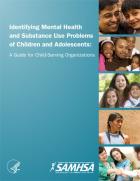
This manual offers guidance and tools for identifying mental illness or substance use issues early in children and adolescents in various setting, such as in schools, the juvenile justice and child welfare system, and when receiving primary care.

This resource guide presents healthcare professionals working with people living with physical and sensory disabilities with information about substance use disorders, including risk factors and warning signs. It also discusses screening, types of substance use services, and strategies for helping clients.

This guide provides clinicians with questions to begin discussions with adult patients about mental illness, substance use disorders, or both. It includes resources for patients who need an evaluation after a positive screening.

This manual guides counselors in the use of medications to help clients achieve abstinence from alcohol. It describes how the medications work and whom may benefit. It also presents the side effects of three FDA-approved medications: acamprosate, disulfiram, and naltrexone.

This toolkit offers tools to implement the evidence-based practice of Assertive Community Treatment (ACT). ACT offers customized, community-based services for people living with mental illness. The toolkit includes a brochure (English, Spanish), a PowerPoint presentation, and an introductory video.

This white paper report identifies and proposes strategies to address Medicaid and other reimbursement policies that may pose barriers to mental health services in primary care settings. It presents findings, discussion by an expert panel, and recommended action steps.

